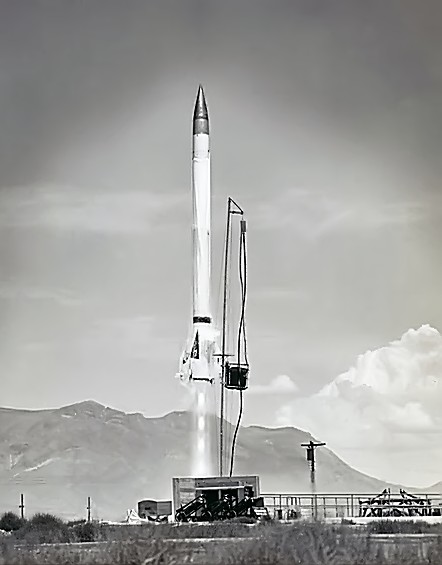
Sixty-three years ago today, a United States Navy Viking rocket soared to an altitude of 136 miles. In doing so, it eclipsed the previous single stage altitude record of 114 miles set by a captured German V-2 rocket on Tuesday, 17 December 1946. The mission was part of the Navy’s 12-flight Viking Rocket flight test series conducted between May 1949 and February 1955.
At 1659 UTC on Tuesday, 07 August 1951, Viking No. 7 was fired from LC-33 at White Sands Proving Ground (WSPG), New Mexico. Burnout velocity was 5,865 feet per second following a rocket motor burn time of 72 seconds. Viking No. 7 weighed 10,730 pounds at lift-off (roughly 8,000 pounds of which were propellants) and carried a scientific payload of 394 pounds.
Viking No. 7 was the last of the early Viking rocket configurations which measured 49-feet in length and had a diameter of 32-inches. Starting with Viking No. 8, the rocket’s airframe was modified to carry more propellants for greater altitude performance and measured 42-feet (length) by 45-inches (diameter). This modification allowed Viking No. 11, flown from WSPG on Monday, 24 May 1954, to capture the all-time Viking altitude record of 158 miles.
Although almost forgotten today, the Viking Rocket Program played a vital role in the history of American rocketry. Viking was the first large, liquid-fueled rocket developed by the United States. It’s rocket motor generated 21,000 pounds of lift-off thrust and employed an innovative two-axis gimbal system for pitch and yaw control. Fin-mounted reaction jets provided roll control.
The Viking Rocket Program provided a tremendous amount of scientific data about Earth’s atmospheric properties such as pressure, temperature, density, winds, and composition. Additionally, the Viking rocket formed the technological basis for a number of 1950′s launch vehicle systems including the Navy’s Vanguard satellite launcher and the USAF Titan ICBM.

